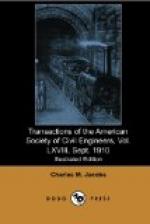The arrangement of the sewers in the streets in the vicinity of the Terminal Site, previous to the beginning of the construction, and the drainage area tributary to those sewers, is shown by Fig. 2. The main sewer for this district was in Eighth Avenue, and was a 6-ft. circular brick conduit within the Terminal area. The sewers leading to it from the west, in 31st, 32d, and 33d Streets, were elliptical, 3 by 2 ft., and egg-shaped, 4 ft. by 2 ft. 8 in., although in no case did they drain more than one block, and they were on a heavy grade. Draining into Eighth Avenue from the east, the one on 31st Street was 4 ft. by 2 ft. 8 in., egg-shaped, and drained a length of two blocks, and those on 32d and 33d Streets were circular, 4 ft. in diameter, and drained the territory for three blocks, or as far east as Fifth Avenue. There were no sewers in Seventh Avenue within the Terminal area, except small vitrified pipes, each less than 200 ft. in length.
It was desirable that the size and number of the sewers in the streets and avenues surrounding the Terminal should be reduced to a minimum, on account of the difficulty of caring for them during construction and also to reduce the probability of sewage leaking into the underground portion of the work after its completion. With this in view, the plan was adopted of building an intercepting sewer down Seventh Avenue from north of 33d Street to the 30th Street sewer, which, being a 4-ft. circular conduit, was sufficiently large to carry all the sewage coming from east of Seventh Avenue and south of 34th Street. It was decided to build this sewer of cast iron where it crossed the proposed construction work, and also to replace with cast iron the brick sewers on 31st, 32d, and 33d Streets from Seventh Avenue to a point east of the west end of the standard tunnel section, and also the sewer on Eighth Avenue from the north side of 33d Street to the south side of 31st Street. This arrangement permitted: first, the removal of the sewer in 32d Street between Seventh and Eighth Avenues, which was necessary, as that street was to be excavated; second, the reduction of the sewer in Eighth Avenue from a 6-ft. to a 5-ft. circular conduit; and, third, assuming that the sewage and drainage from the Terminal would be pumped directly to the sewers in the avenues, the reduction of the sewers in 31st and 33d Streets, from Seventh to Ninth Avenue, to 15-in. vitrified pipes, except west of the Service Building in 31st Street, to accommodate which section, a larger sewer was required. The sewer in 32d Street, from Ninth to Eighth Avenue, of course, could be dispensed with in any arrangement, as all the area tributary to it was to be excavated.
[Illustration:
Fig. 2.
Plan showing layout of
sewer in catchment area about
terminal station]




